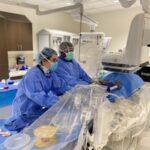.jpg) As those of you follow this column on a regular basis are well aware, the Florida Heart Research Institute has made an institutional commitment to improve the survival from sudden cardiac arrest in our community and in our world. In keeping with our mission to stop heart disease through research, education and prevention, we are deeply impressed (if not depressed) that survival from out of hospital cardiac arrest hovers around the 7% range, while research has demonstrated that dramatic community efforts, at least for a segment of that population, can increase that number closer to 50%. In order to achieve this goal, each component of the response must be activated and maximized. These are commonly referred to as the critical links in the chain of survival: recognition (CALL 911), CPR (PushCPR), AED (defibrillation), Advanced Care (EMS and hospital care).
As those of you follow this column on a regular basis are well aware, the Florida Heart Research Institute has made an institutional commitment to improve the survival from sudden cardiac arrest in our community and in our world. In keeping with our mission to stop heart disease through research, education and prevention, we are deeply impressed (if not depressed) that survival from out of hospital cardiac arrest hovers around the 7% range, while research has demonstrated that dramatic community efforts, at least for a segment of that population, can increase that number closer to 50%. In order to achieve this goal, each component of the response must be activated and maximized. These are commonly referred to as the critical links in the chain of survival: recognition (CALL 911), CPR (PushCPR), AED (defibrillation), Advanced Care (EMS and hospital care).
Hospitals: The Link to Life?
Clearly, the area which requires the greatest improvement is the very area in which the medical profession has the least control/impact – the early recognition of the problem, the prompt call to 911 and the immediate initiation of effective cardiopulmonary resuscitation. Since time is of the essence, every minute that vital organs, especially the brain, are deprived of oxygen, they start to die. Resuscitative efforts within the first five minutes of arrest are always the most effective. If there is a delay in recognizing the problem, a delay in calling 911, and a further delay in starting CPR (waiting for the “cavalry,” i.e. EMS to arrive), all hope of meaningful recovery may well have vanished before any professional help is available.
But what happens when they do arrive? Of the 350,000 or so victims of sudden cardiac arrest in this country each year, only about 40,000 survive to hospital admission. Of these, only about one third is discharged to a meaningful recovery. The question then arises, even if we were able to dramatically improve our response times to increase survival of the initial event (clearly the area in which right now improvements would provide the most “bang for the buck”), is there anything we can do to improve the survival and recovery of neurologic function for those who do make it to the hospital? In fact, should we dramatically improve our initial response, the first three links in the chain, the onus would then fall on the hospitals to be able to offer improved avenues for survival.
In the early days of cardiac surgery, repair of complex congenital anomalies required a longer time working on a motionless heart than the techniques of myocardial preservation at that time could provide. Extensive study was made of the impact of hypothermia on preserving brain and other vital organ function in the absence of circulation. Although deep hypothermic circulatory arrest is still used for selected operations, the potential of using reduced temperature for vital organ preservation has been applied to victims of cardiac arrest. Studies have demonstrated that patients who remain comatose after return of spontaneous circulation (i.e. the heart is now working fine but the brain isn’t and the patient is not responding) can be effectively cooled for 12-24 hours to about 5oC (around 10 degrees Fahrenheit). The result after rewarming? Meaningful survival increases from the 25-40% range to the 50-55% range. Still far from perfect, but if you or your loved one happened to be one of the 15-25% saved, you would certainly be grateful. Such interventions into human physiology are not simple. They require careful monitoring in an intensive care setting, with frequent blood sampling, and prompt recognition and treatment of potential complications. However, the sooner following arrest the cooling begins, the better the result. How long should people be kept cold? How fast can they and should they be cooled? Rewarmed? How do we determine who is likely to survive and in whom such aggressive therapy is futile? What adjunctive therapies might facilitate the protective effects of the hypothermia? These are all questions for current and future research. Suffice it to say, the hospital and the advanced medical community still have a vital role to play in this process by providing the final link in a chain of survival and return to meaningful life.

























